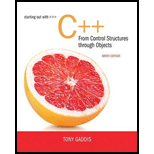
Concept explainers
Month Class
Design a class named Month. The class should have the following private members:
name A string object that holds the name of a month, such as “January,” “February,” and so on.
monthNumber An integer variable that holds the number of the month. For example, January would be 1, February would be 2, and so on. Valid values for this variable are 1 through 12.
In addition, provide the following member functions:
• A default constructor that sets monthNumber to 1 and name to January.
• A constructor that accepts the name of the month as an argument. It should set name to the value passed as the argument and set monthNumber to the correct value.
• A constructor that accepts the number of the month as an argument. It should set monthNumber to the value passed as the argument and set name to the correct month name.
• Appropriate set and get functions for the name and monthNumber member variables.
• Prefix and postfix overloaded ++ operator functions that increment monthNumber and set name to the name of next month. If monthNumber is set to 12 when these functions execute, they should set monthNumber to 1 and name to “January.”
• Prefix and postfix overloaded — operator functions that decrement monthNumber and set name to the name of previous month. If monthNumber is set to 1 when these functions execute, they should set monthNumber to 12 and name to “December.”
Also, you should overload cout’s ≪ operator and cin’s ≫ operator to work with the Month class. Demonstrate the class in a program.
Want to see the full answer?
Check out a sample textbook solution
Chapter 14 Solutions
Starting Out with C++ from Control Structures to Objects (9th Edition)
Additional Engineering Textbook Solutions
Modern Database Management
Degarmo's Materials And Processes In Manufacturing
Java: An Introduction to Problem Solving and Programming (8th Edition)
Concepts Of Programming Languages
SURVEY OF OPERATING SYSTEMS
Management Information Systems: Managing The Digital Firm (16th Edition)
- Considering the TM example of binary sum ( see attached)do the step-by-step of execution for the binary numbers 1101 and 11. Feel free to use the Formal Language Editor Tool to execute it; Write it down the current state of the tape (including the head position) and indicate the current state of the TM at each step.arrow_forwardI need help on inculding additonal code where I can can do the opposite code of MatLab, where the function of t that I enter becomes the result of F(t), in other words, turning the time-domain f(t) into the frequency-domain function F(s):arrow_forwardI need help with the TM computation step-by-step execution for the binary numbers 1101 and 11. Formal Language Editor Tool can be used to execute it; Write it down the current state of the tape (including the head position) and indicate the current state of the TM at each step;arrow_forward
 Microsoft Visual C#Computer ScienceISBN:9781337102100Author:Joyce, Farrell.Publisher:Cengage Learning,
Microsoft Visual C#Computer ScienceISBN:9781337102100Author:Joyce, Farrell.Publisher:Cengage Learning, EBK JAVA PROGRAMMINGComputer ScienceISBN:9781337671385Author:FARRELLPublisher:CENGAGE LEARNING - CONSIGNMENT
EBK JAVA PROGRAMMINGComputer ScienceISBN:9781337671385Author:FARRELLPublisher:CENGAGE LEARNING - CONSIGNMENT C++ for Engineers and ScientistsComputer ScienceISBN:9781133187844Author:Bronson, Gary J.Publisher:Course Technology Ptr
C++ for Engineers and ScientistsComputer ScienceISBN:9781133187844Author:Bronson, Gary J.Publisher:Course Technology Ptr Systems ArchitectureComputer ScienceISBN:9781305080195Author:Stephen D. BurdPublisher:Cengage LearningProgramming Logic & Design ComprehensiveComputer ScienceISBN:9781337669405Author:FARRELLPublisher:Cengage
Systems ArchitectureComputer ScienceISBN:9781305080195Author:Stephen D. BurdPublisher:Cengage LearningProgramming Logic & Design ComprehensiveComputer ScienceISBN:9781337669405Author:FARRELLPublisher:Cengage C++ Programming: From Problem Analysis to Program...Computer ScienceISBN:9781337102087Author:D. S. MalikPublisher:Cengage Learning
C++ Programming: From Problem Analysis to Program...Computer ScienceISBN:9781337102087Author:D. S. MalikPublisher:Cengage Learning





